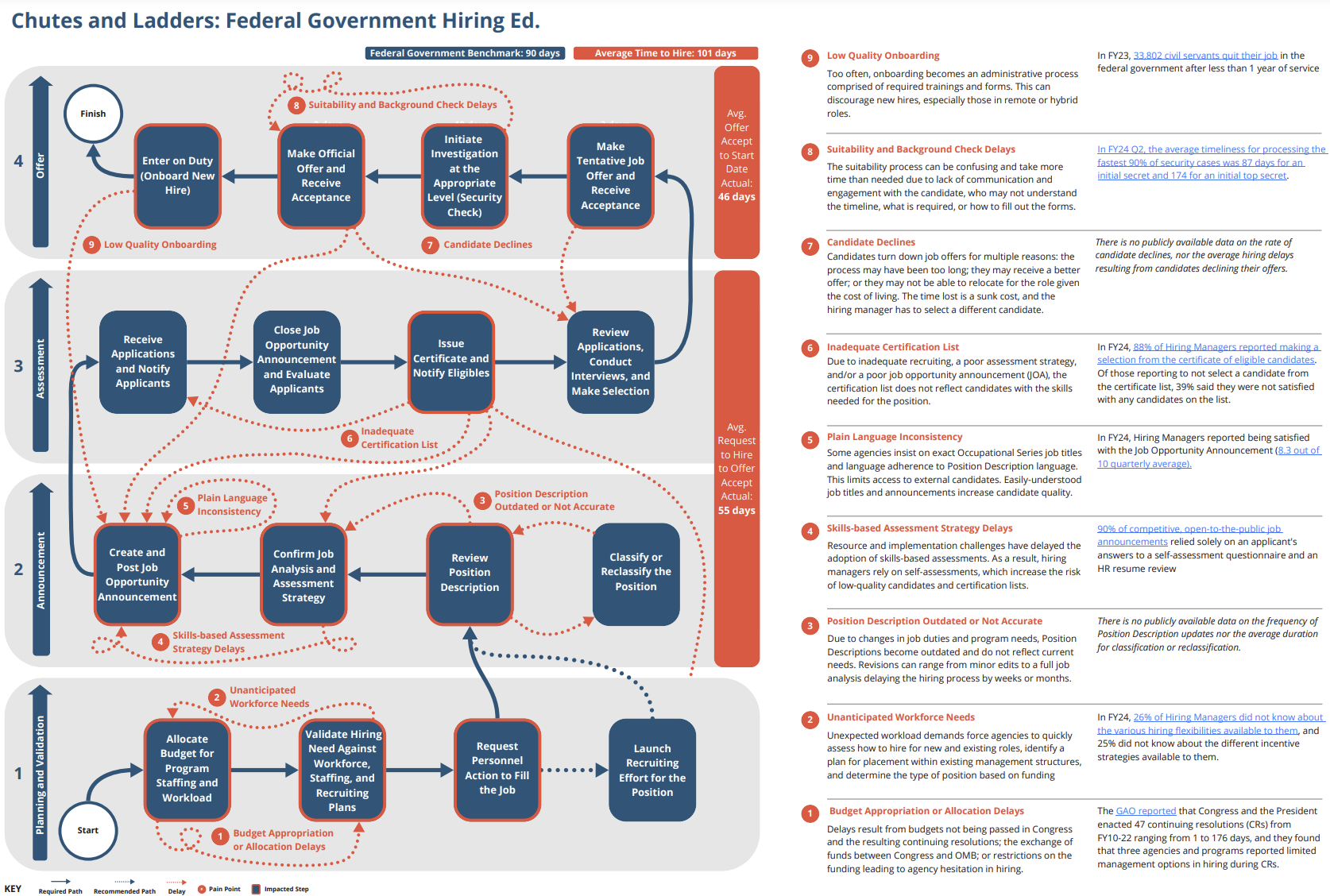
Many Chutes and Few Ladders in the Federal Hiring Process
How hard can it be to hire into the federal government? Unfortunately, for many, it can be very challenging. A recent conversation with a hiring manager at a federal regulatory agency, shed light on some of the difficulties experienced in the hiring process.
A Hiring Experience
This hiring manager – let’s call her Alex – needed to hire someone to join her team and support environmental review efforts (e.g., reviewing the impact of building a road near a wetland) towards the end of 2023. It was a position she had hired for previously, and she had a strong understanding of the skills and knowledge that a candidate would need to be successful in the role.
Luckily, she did not need to create a new job description, classify the position, or create a new assessment. Instead, she was able to use the previous job description, job analysis, and assessment, only making small tweaks. This meant that she just needed to work with the HR Specialist (personnel who provide human resource management services within their agency) to finalize the Job Opportunity Announcement (JOA).
This was happening in December and given the holidays, she decided to wait on posting the JOA until the new year. They posted the announcement in early January and closed the application a week later. Alex publicized the opening through her network on LinkedIn and through other LinkedIn pages.
Anxious to bring a new teammate on board, Alex was quite frustrated to not receive a certified list of candidates from the HR Specialist until four months later. And when she began her review of the candidates, she was surprised to find only one applicant with the experience and skills she was looking for in the role. Alex reached out to the candidate, but learned that they had already accepted a different role.
Feeling disheartened, Alex contacted the HR Specialist to ask for a second list of candidates, explaining the incompatibility of the other applicants in the initial list. Alex waited until June to receive the second list, now six months past the posting date, but she was excited to see several qualified candidates for the role.
Following their evaluation process, Alex made an offer to a candidate from the list. With the tentative offer accepted, they started the background check, which took about two months. The candidate finally started in September, nine months after posting the position.
Now, what happened? Why did it take nine months to fill this position, especially when the job announcement only required small changes?
Mapping the Hiring Process
In our recent blog post, we shared how difficult it is to hire into the federal government and cited a number of different challenges (e.g., outdated job descriptions, reclassifying roles, defining an assessment strategy, etc.) hindering the government from building talent capacity. We decided to map out the federal government’s competitive hiring process to illustrate how the hiring process typically works and where pain points often emerge. Through research (e.g., OPM’s Hiring Process Analysis Tool), expert feedback, and practitioner discussions (e.g., interviews with hiring managers, HR specialists, and leaders involved in permitting activities), we outlined the main steps of the hiring process from workforce planning through candidate selection and onboarding. And we found the process to look similar to a game of Chutes and Ladders.
As you’ll see, the hiring process is divided into four major phases: (1) aligning the workforce plan and validating the hiring need, (2) developing and posting a job opportunity announcement, (3) assessing the candidates, and (4) selecting a candidate and making an offer. Distributed throughout this process, we identified nine primary pain points that drive the majority of delays experienced by civil servants.
In the first phase, the major challenges experienced are receiving the funding to begin the hiring process and realigning the workforce plan to account for the new role, especially when there is a talent surge that was unanticipated. In the case of environmental permitting, the Inflation Reduction Act (IRA) and Bipartisan Infrastructure Law (BIL) provided significant funding to support talent acquisition, but agencies had not planned for the talent surge. These new talent needs did not align with their existing workforce plans nor their capacity to recruit, source, assess, and bring new staff onboard.
Additionally, budget availability has also caused a number of delays. The new legislation only provides short-term funding for talent or in other cases, is unclear how the funds can be used for staffing. As a result, agencies have hesitated in hiring. They are left weighing the tradeoffs of hiring for full time employees with uncertain future funding or hiring for term positions (i.e., roles with a limited duration). Analyzing retention and retirement rates have helped some agencies navigate this decision, but the desire to avoid future layoffs combined with the risk averse culture has made the process difficult. Some have decided to hire for term positions, but have struggled in recruiting talent interested in a short-term role. Ultimately, this short-term funding does not help address long-term talent capacity gaps.
In the second phase of the process, the pain points center around developing and preparing the final job opportunity announcement (JOA). This can be delayed if there is not a position description that accurately captures the role, there is not a strong assessment strategy, or the HR Specialist and Hiring Manager disagree on the language to be used in the announcement.
With permitting-related positions, many agencies have been looking to hire for interdisciplinary positions that have a range of expertise. OPM, the Permitting Council, and agencies have worked to create interdisciplinary position descriptions and announcements across technical disciplines. Developing the job descriptions, confirming the job duties, and formulating an assessment strategy takes more time, ultimately resulting in a longer time to hire.
Even for positions that are more regularly used across agencies (e.g., Environmental Protection Specialist) descriptions may be available and up to date, but there may not be an assessment for a particular grade. For example, OPM and the Permitting Council collaborated to create a pooled hiring, cross-government announcement for a multi-grade Environmental Protection Specialist (EPS). This allowed for one JOA to produce a list of candidates that many agencies could use for hiring. Yet the assessment remained somewhat of a bottleneck because there were not standard assessments available for each grade (e.g., GS-5-14) in the JOA, which required more time for assessment development. This is not unique; for many positions, standard assessments do not exist for each grade.
In the third phase, the primary challenge is a lack of qualified candidates. Hiring managers receive a list of candidates (i.e., certificate list) who should meet the requirements of the position, but that is not always the case. This can result from a number of issues ranging from the use of self-assessments and HR Specialists lacking the expertise to screen resumes to insufficient recruiting efforts.
In discussions with civil servants looking to hire for permitting-related positions, we have heard these challenges. Some agencies have struggled to make time for efforts given their limited capacity, resulting in a limited applicant pool. Alex’s story provides another example. Alex and their HR Specialist selected a self-assessment strategy, where applicants report their level of experience and skills on a number of questions related to the role. Both self-inflation and humility can distort these scores, resulting in qualified candidates not making it through the process. In reviewing the first certification list, Alex explained being surprised to see individuals with resumes unrelated to the role. This likely resulted from inaccurate self-assessment scores combined with a lack of expertise among the HR Specialist to effectively screen the resumes for the position. Receiving a certificate list with unqualified candidates can significantly delay the process, and in Alex’s case, result in another two month delay.
In the last phase of the process, delays often result from candidates declining their offer and the time required for background checks. Candidate declines can be very demotivating for a Hiring Manager who is excited to bring on the candidate they selected. Candidate declinations are a challenge for permitting-related positions. This is often due to constraints in negotiating salaries and relocation requirements, especially when candidates are asked to move to an area with a high cost of living. With today’s high interest rates, some candidates are just unable to move given the federal government’s stagnant pay structure.
Improving Alex’s Experience
Thinking back to Alex, this process highlights some areas where the process went astray, particularly with the assessment and HR Specialist screening. These issues can be solved through skills-based hiring and better assessment tools such as Subject Matter Expert Qualification Assessment (SME-QA) (i.e., a process that incorporates subject matter expert resume reviews into the screening process). However, an often-overlooked challenge, not highlighted in the process map, is the relationship between the Hiring Manager and HR Specialist.
The breakdown in communication between HR Specialists and Hiring Managers is not uncommon. Building a strong relationship and shared ownership across the hiring process is key to success. In Alex’s case, she was discouraged from reaching out to the HR Specialist with questions because of the HR team’s limited capacity; the team was centralized across their organization and responsible for servicing many offices. This left Alex frustrated. The process felt like a black box, leaving her with no insight as she waited for her certificate list to eventually arrive. A kickoff meeting with the HR Specialist to align on a timeline, establish roles and responsibilities, and form a line of communication to share updates throughout the process could have helped open and shine light in the black box, fostering a collaborative relationship to identify and mitigate issues as they arose throughout the process.
Summary
When we take a step back and look at this hiring process, it can feel daunting. The average time to hire one candidate is 101 days. In comparison, the private sector takes less than half the time. While it may not be possible for this current process to meet the private sector’s timeline, there are things that can be done to streamline today’s process. In our next series of blog posts, we will dive into each phase in more detail and highlight short-term solutions for hiring managers, HR specialists, program managers, and budget personnel to bypass these chutes — and focus on the ladders.
Without the permitting workforce needed for implementation, the American public will not reap the benefits of rural broadband access, resilient supply chains, and clean, accessible water.
As data fuels the next transformative modernization phase, the federal government has an opportunity to leverage modern practices to leap forward in scaling IT modernization.
